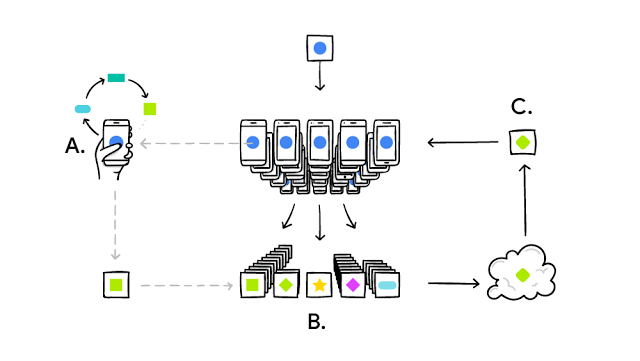How attention tokens take ad-blocking into a Brave new future

Don’t get me wrong, the idea of raising $35 million in crowdfunding in just 24 seconds using cryptocurrency and without giving away a single share of the company is amazing. And it’s understandable why that would be the take-away for most folks from ad-blocking browser startup Brave’s recent initial coin offering (ICO) — indeed, it feels like the firing pistol for a pack of ICOs in the early summer of 2017. Just a few weeks later the Bancor ICO set new heights of funding velocity: $153 million in token sales, with one buyer snapping up $27 million for a project still in alpha.
But here’s the most interesting part of the Brave offering for me — and should be for anybody who still is bothered by the appropriation by Facebook and Google’s near-stranglehold on all growth in U.S. digital advertising spend (99% according to one estimate). Brave’s white paper makes the case strongly that these two ad juggernauts produce no original content, and instead redirect much-needed revenue away from content publishers into the pockets of middlemen. In its whitepaper on “Blockchain-based Digital Advertising,” Brave claims to offer
“a bond with users that proves that not only does their data hold value, it holds substantial value that has been ignored and exploited by the middlemen year after year in the current industry model.”
What is so refreshing about the Brave offering is that people are offered a new asset class based on Attention, specifically Basic Attention Tokens (BATs). The idea is simple, and — yes — brave: Reclaim sovereignty of users’ attention data by architecting a browser that controls who sees what the user looks at online, and fuel its adoption by allowing her to block ads.Ad-blockers are a fact of life, Paul Berry — the original CTO for HuffPo — told us they were a “‘movement” back in 2015. So when Brendan Eich (the guy who invented JavaScript at Netscape) and an amazing team builds a privacy-protected-by-design browser with an internal attention recorder that allows you to see where all your useful consciousness went — and control who tracks browsing activity — that’s not just cool, it’s overdue. It’s payback, baby.People have been trying to do this for a long time. A tip of the hat here to Steve Gillmor and Seth Goldstein, who published a manifesto on this topic back in 2005, a time when people were optimistic about the social impact of a Web 2.0. Seth actually built an attention recorder, with beautiful data visualizations (via Stamen as I recall).But that was before Facebook. Caught in the crossfire between Social and Attention is my old friend (who should also be yours), Identity.
Doc Searls famously tried to connect the two with his Vendor Relationship Management (VRM) model, where users published selected data to marketers in a kind of reverse auction format. The problem that VRM faced in going to market is that reversing the polarity of Attention — so Brand notices Customer — is like making water run uphill. So instead, Facebook and Google’s respective ad partners auction off our Identity to Brand.Working as a presence of a European telco, we at Orange Silicon Valley are sensitive to Identity, (1) because SIM cards in phones are viewed as the key to digital inclusion by the United Nations, and (2) because the European Union is now executing on the General Data Protection Regulation (GDPR) regime. That regulation kicks in as of May 2018 for anybody providing services to the EU. It covers how service providers of all kinds (including presumably programmatic ad exchanges) must protect personal data, a.k.a. Identity.
Let your fingers do the walking
Identity as an asset class with fungible, even balance-sheet value, of course goes deeply back into the industry I work in, telecom. Once upon a time, Big Telco was considered the registrar of last resort. They published phone books; they maintained databases of millions of subscribers (which was considered Big Data before the term existed).Today, even though Orange sells a straightforward SIM-based authentication product, I find many telco executives ambivalent about Identity as an interesting product area for innovation. With all due respect, I think they’re wrong.What Brave does is seed the three-sided ecosystem of User/Publisher/Advertiser with Attention as an asset class that resets the balance of power. Brave’s allocation of its initial (and only) offering of 1 billion coins — sets aside 200 million coins for developers and 300 million BATs for incentivizing a User Growth Pool.As several of my colleagues were quick to pick up on, what makes Brave’s approach convincing here in allocating coins is the onboard, rechargeable wallet loaded into the browser. That’s exciting.
A bigger win: derisking machine learning?
Just how early users do spend BATs will be fascinating to watch, and I suspect it will spin up unexpected use cases that will make Identity skeptics palm-slap (“toll-free affinity groups, why didn’t we think of that!”). Massive, thick value can be unlocked from anonymized metadata, which in turn empowers publishers to sell high-quality (because it’s accurate) inventory to marketers, who are no longer polluters of attention but doing that thing everybody pays lip service to but doesn’t do— serve truly relevant ads.But even better than that, it drives machine learning into a corner — our pocket. This is where Brave and Google do have something in common, which is machine learning at the edge. Brave puts it this way:
“Your data, studied and abstracted by on-device-only machine learning, provides you with private and anonymous options to get compensated for your attention.”

This idea of keeping data on-device, and federating the learnings from neural nets at the device level, is also a model Google is talking about, and in fact calls Federated Learning (thanks to Dan Elitzer at IDEO Co-Lab for this tip). There, training data stays on the phone, while incremental improvements in the model are anonymized and sent to the cloud — very similar.
From Google Research Blog: “Your phone personalizes the model locally, based on your usage (A). Many users’ updates are aggregated (B) to form a consensus change © to the shared model, after which the procedure is repeated.”
That we can put it together and combat the runaway inefficiencies in how our attention is monetized today by monetizing users along with the other players in the ecosystem, is a brave new world worth our attention.
Disclaimer: The views and opinions expressed in this article belong to the author and do not necessarily reflect the position or views of Orange or Orange Silicon Valley.
Original Link: How attention tokens take ad-blocking into a Brave new future
By Mark Plakias
Já baixei o Bravo e estou usando no smartphone e no desktop. Vi no site que qq publisher pode se cadastrar, ser verificado e começar a recomendar a navegação pelo Bravo. De repente o Steemit pode entrar nessa e integrar o STEEM com o BAT de alguma forma. Valeu!
Seria muito bom. O navegador do celular é incrivelmente mais rápido . O projeto da Brave é grande e ambicioso .